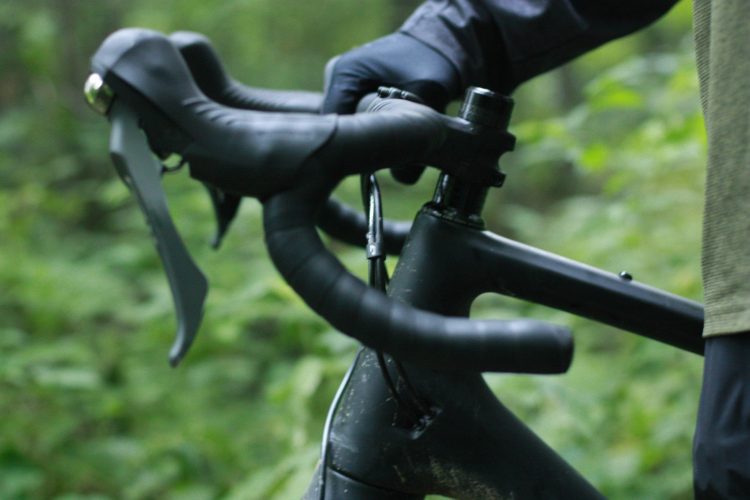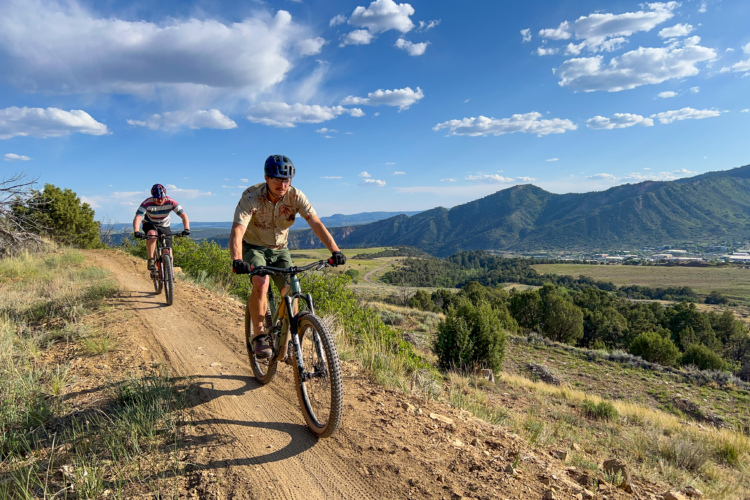The Ibis Mojo HD3, the long awaited third generation of the popular Mojo, made its debut last November and was on hand for demo at Outerbike. Ibis set up their demo area near the entrance of the event, and these particular bikes were very hard to come by throughout the weekend, demanding attention with beautiful aesthetics, top of the line specs, and a reputation to haul the mail on the trail.

Speaking to the mechanics, Ibis went the extra mile to redesign an already-capable Mojo from the ground up to maximize every benefit from the 27.5in platform and tried-and-true DW-link suspension. Contemporaneous with modern trail bikes, this long, low, slack Mojo was engineered to elevate weekend warriors up the Strava food chain, and put pros on the podium with six inches of silky-smooth travel.

The stiff carbon frame was made even lighter than its predecessor, with deft internal cable routing for a clean, low-maintenance rig. This was made possible by the clevis design, lighter linkages, and new bearings that also buttress lateral stiffness.

The Deets (from Ibis Cycles)
- 650b (27.5″) wheels
- The most advanced version of the dw-link suspension on the planet
- 6” (150mm) of rear wheel travel
- Carbon fiber monocoque frame and swingarm
- Weight for the frame and shock, size large, matte finish: 5.9 lbs
- 67 degree head angle with a 150mm fork (66.6º with 160 fork)
- Shock specs: Fox Float CTD Adjust Factory Series with Kashima Coat, 7.875″ x 2.25″, 175lb boost, med velocity, med rebound, LV can, .92in3 volume spacer,
- Optional shock: Cane Creek DBinline
- ISCG 05 compatible with removable adapter
- Threaded bottom bracket
- Super versatile internal cable routing including internal dropper routing.
- Optional polycarbonate down tube cable guard
- Chain stay length: 16.9″
- 12 x 142mm Maxle rear axle
- 160mm post mount left dropout, carbon fiber
- Tapered Head Tube and Steerer
- Up to 2.4″ rear tire depending on brand and height of cornering knobs
- Dual row angular contact bearings on the drive side of the lower link that have less play than standard sealed bearings. Preload adjustment is not necessary. Large 28mm x 15mm x 7mm radial bearings on the non drive side for stiffness and long wear
- Bottom Bracket height 13.4″
- Removable direct mount front derailleur mount for a clean 1X look
The HD3 was well thought out with options to run internal cables and save a few grams, as well as internal dropper post routing with both hydraulic and internal wire lines. An optional bolt-on polycarbonate guard protects the frame. There are also options for multiple drivetrain configurations (an option that is slowly becoming extinct), to run 1x, 2x, 3x, or a combination of aftermarket modifications. The frame is also chain guide-compatible and has a 68mm threaded bottom bracket. Ibis says that the frame will fit up to a 2.4 inch tire for the hardcore Endurophiles (you know who you are).
This frame is also designed to comfortably fit Ibis’s proprietary 41mm rims (pictured here). For more info on these uber-wide rims, be sure to read Greg’s review here.
Ride Impressions
Ibis boasts about the new Mojo HD3 on the their website, but a bike is only as good as how it handles on the trail. The size-medium demo bike that I tested had some choice components on it such as a Fox 36 fork, Cane Creek DB Air, RaceFace Turbine cinch cranks, KS LEV dropper post, Maxxis Minion DHFs, and and XTR derailleur. Hard to go wrong with that build if your goal is to give gravity the middle finger on your way to the Enduro trophy case.
My friends literally make fun of me because I am so picky about bikes and components (but you should be if you are dropping $5000-$10,000 on a bike, right?!), but I was instantly impressed with the Mojo HD3. More than anything, I could not believe how plush this bike felt from the first few strokes on a rocky trail. The small bump compliance was phenomenal, better than any other bike I’ve ever ridden, gently soaking up trail chatter and bigger rocks on the trail. I’m sure the Fox 36 and DB Air has a lot to do with that, but the DW link and new linkages on this bike are a noticeable improvement over previous Mojos, and other competitor’s bikes for that matter. Steering was decisive, and it was a capable climber for the amount of travel the HD3 has. For once, I literally have nothing critical to say about this bike in the limited hour or so I took it on the trail.

One of our testers, however, who normally rides an XL frame, said the Large frame he rode felt less playful than expected, and he wasn’t as impressed as I was. He rode the bike on part of Mag 7 in Moab, for much longer than I did, over burlier terrain, with drops and a monster road climb out of a valley. He noted that he did not have anything negative to say about the HD3, but did not feel the suspension was as incredible as I thought it was. Take home: ride the correct frame size, set up the suspension correctly, and ride one for yourself.
I personally regret that I did not have more time on this bike. For riders that are looking for a versatile all-mountain bike with a well-thought-out frame and suspension, the Ibis HD3 is one I’d recommend on a short list in a large field of bikes in this category. Having spent time on tons of bikes in the past few years, it is one of my favorites.













7 Comments
Mar 20, 2015
Mar 18, 2015
Mar 20, 2015
Mar 19, 2015
I fully intended to buy an HD3 as a second bike (yes, I know they are essentially the same bike) but once again, I'm just so happy with the performance of the Mach 6 in EVERY aspect that I've decided to hold off for now. Nothing against the HD3 of course as I've steered my closest riding buddy to that bike but there's nothing that I can honestly say I wish my Mach 6 did better.
Mar 17, 2015
Mar 17, 2015
Mar 17, 2015
The Maxxis Minion DHF and DHR are proven to work well with those rims, which is why they were spec'ed :)